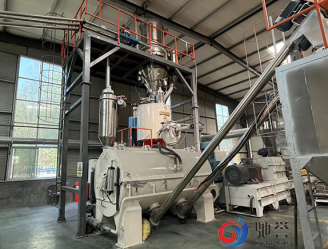Copyright © 2021 Zhangjiagang ChiYu Automation Equipment Co., Ltd. by iwonder.cn All rights reserved. Site Map
High-speed mixers play a critical role in various industries, including plastics, pharmaceuticals, and food production. To ensure these mixers perform at their best, regular maintenance and careful operation are essential. This guide will cover the key maintenance steps, safety considerations, and tips to keep your high-speed mixer running smoothly.
Proper maintenance of high-speed mixers not only extends the equipment’s life but also helps maintain consistent product quality, minimizes downtime, and reduces repair costs. For those working with high-speed industrial mixers, adhering to maintenance schedules can prevent unexpected breakdowns and ensure safe and efficient operations.

When using a high-speed mixer, it’s vital to follow the operating instructions carefully and establish a maintenance routine. In addition to general equipment maintenance, pay special attention to the following areas:
1. Follow the Equipment Operating Instructions
Always refer to the manufacturer’s operating instructions as your primary guide. Following these instructions will help ensure that all equipment functions are executed safely and properly, minimizing the risk of damage or mishandling.
2. Start Equipment Before Adding Materials
To avoid damage or imbalance, start the high-speed mixer before adding any materials for mixing. Gradually add the material based on the recommended sequence and capacity guidelines. This procedure helps avoid overloading the mixer and ensures uniform mixing without excessive strain on the motor or other components.
3. Inspect and Replace Key Components
Certain components, such as sealing rings, rubber rings for couplings, V-belts, and rolling bearings, are essential for optimal operation but are prone to wear. Regularly inspect these parts for any signs of damage or wear, and replace them as necessary to prevent leaks, mechanical failure, or power transmission issues.
4. Check Fasteners and Clean Regularly
Ensure that all fasteners are tightened properly and inspect the tightness of the V-belt. Clean the equipment thoroughly and remove any dust or residue that may accumulate over time. Regular cleaning not only improves efficiency but also helps prevent contamination in mixing processes, especially important in food and pharmaceutical applications.
Scheduling an annual inspection and servicing is recommended to address deeper mechanical and structural needs. Here are the critical steps to follow during a yearly inspection:
1. Check Agitator Blade Clearance
The gap between the agitator blade, scraper, and the mixing chamber wall should meet the specifications listed in the maintenance manual. Proper clearance prevents damage to the mixer and ensures that mixing remains consistent across batches.
2. Inspect and Clean Rolling Bearings
Remove, clean, and inspect all rolling bearings. Look for signs of wear or damage, and replace bearings if necessary. Proper bearing maintenance improves the mixer’s rotation and reduces energy loss, contributing to prolonged equipment life.
3. Examine the Main Transmission Shaft
Check the main transmission shaft for any signs of bending or wear. A worn or misaligned shaft can affect mixer performance and lead to costly repairs if not addressed. Straightening or replacing the shaft can prevent mechanical issues and improve overall mixer stability.
4. Check and Replace Cylinder and Seal Components
Inspect the cylinder, replacing any worn seal rings and guide sleeves as needed. Also, check if the piston rod shows any signs of bending, deformation, or wear. Damaged or worn sealing components can lead to leaks, which may affect the mixing quality and create safety hazards.
5. Document Inspections and Prepare for Future Repairs
After completing the maintenance inspection, record details about the state of major components. Documenting findings helps keep track of wear patterns and aids in predictive maintenance planning, allowing for proactive repairs and part replacements that reduce downtime.
High-speed mixers must be operated with care due to their powerful motors and high RPMs. Follow these safety guidelines to protect workers and maintain a safe workspace:
Wear protective gear: Safety glasses, gloves, and ear protection are essential.
Avoid overloading: Never exceed the recommended capacity, as overloading can strain the mixer and increase accident risk.
Turn off power before performing any maintenance or cleaning. Always ensure the machine is completely powered down to prevent accidental activation.
Train operators on emergency shutdown procedures and safe handling of materials.

At Chiyu, we understand the importance of efficient and reliable equipment for your mixing operations. Our line of Automatic Mixers is designed to meet the demands of various industries, ensuring durability, precision, and high performance. With a focus on continuous innovation, we deliver equipment that keeps pace with evolving industry standards and enhances productivity.
Quality and Reliability: As an experienced and reputable automatic mixer manufacturer, we offer top-quality mixers that are built to last.
Industry-Specific Designs: We design mixers suited to specific industries, whether for pharmaceuticals, food processing, plastics, or chemicals.
Dedicated Support and Services: Our team provides complete support, from product selection to post-purchase maintenance advice.
For further details or inquiries about our products, please click here to contact us. We look forward to partnering with you to enhance your production process with the best in mixing technology.